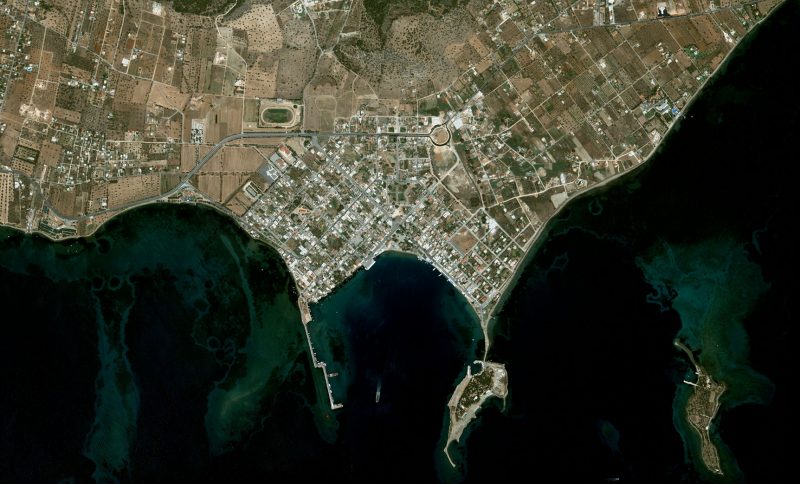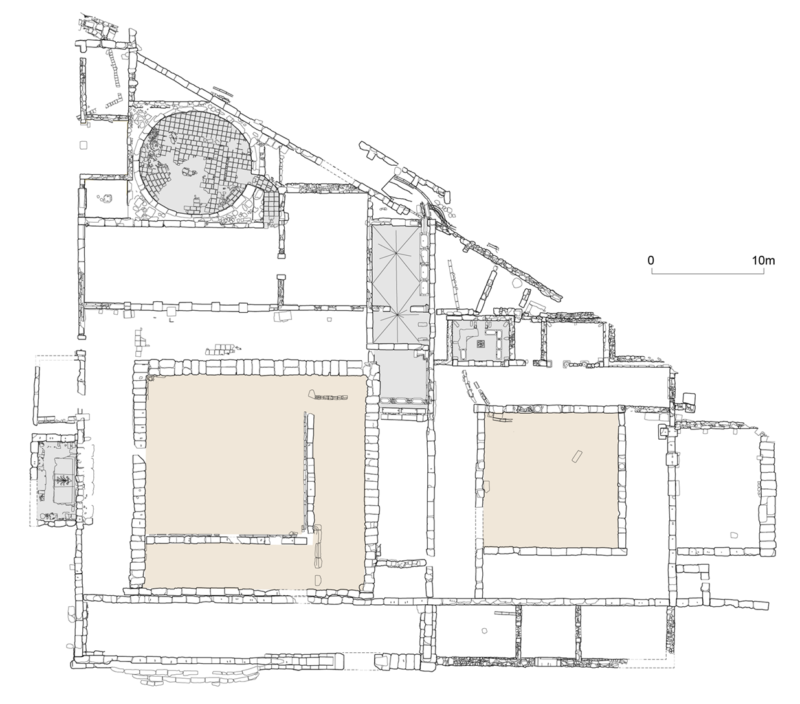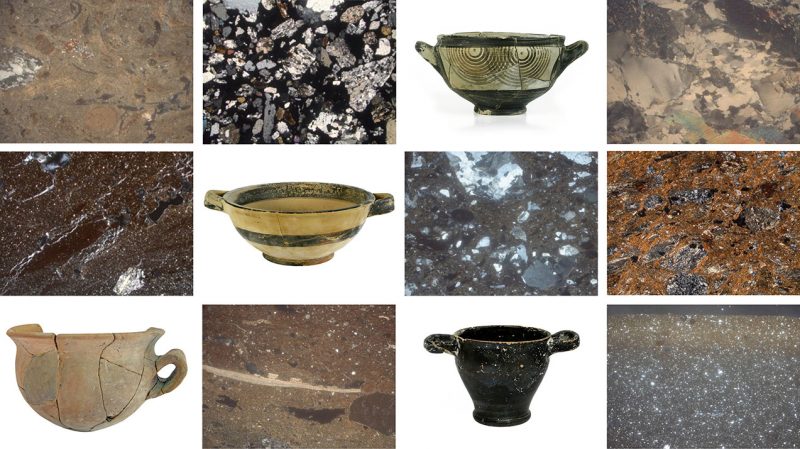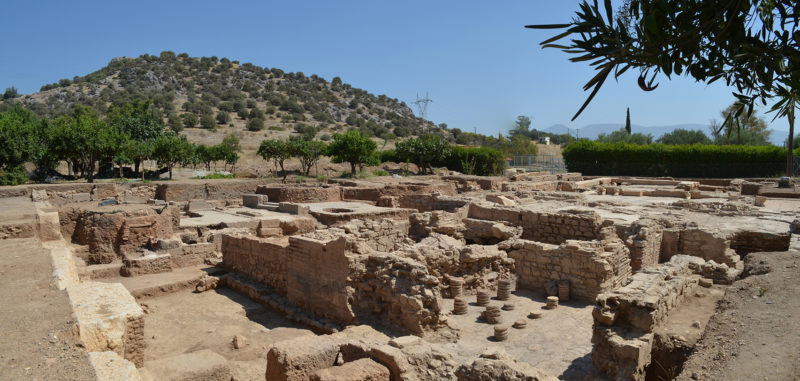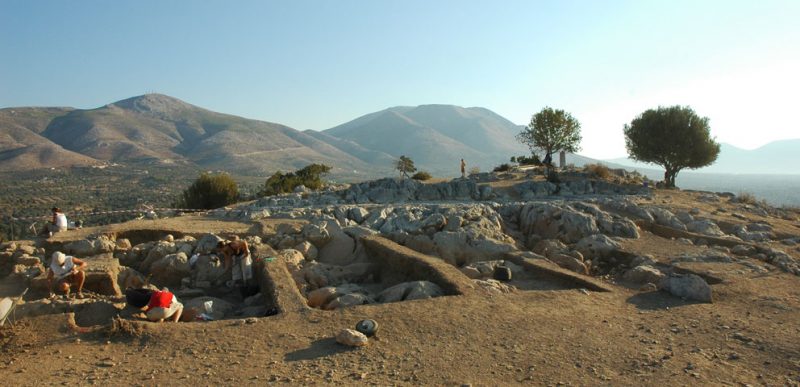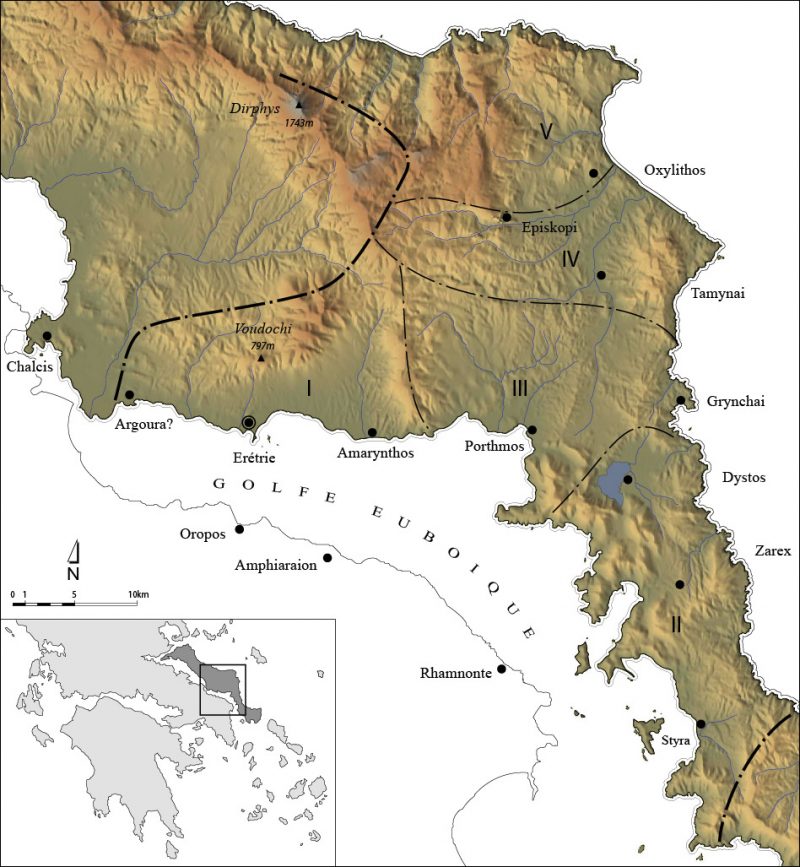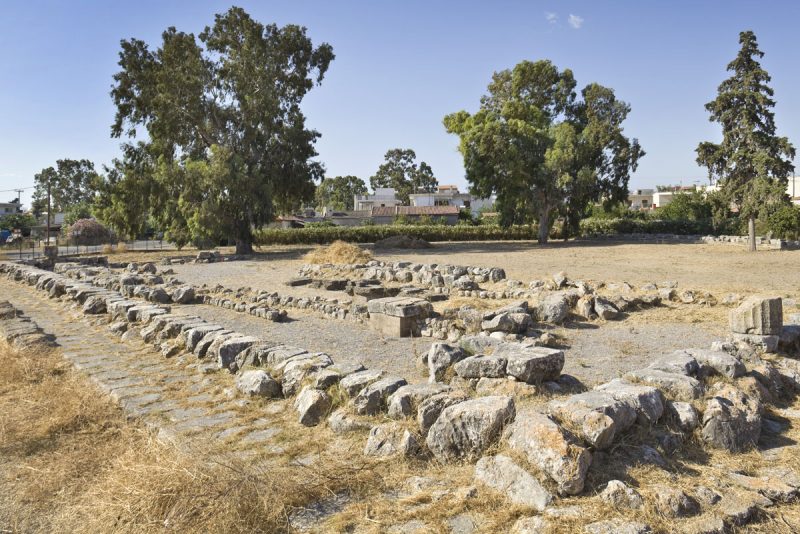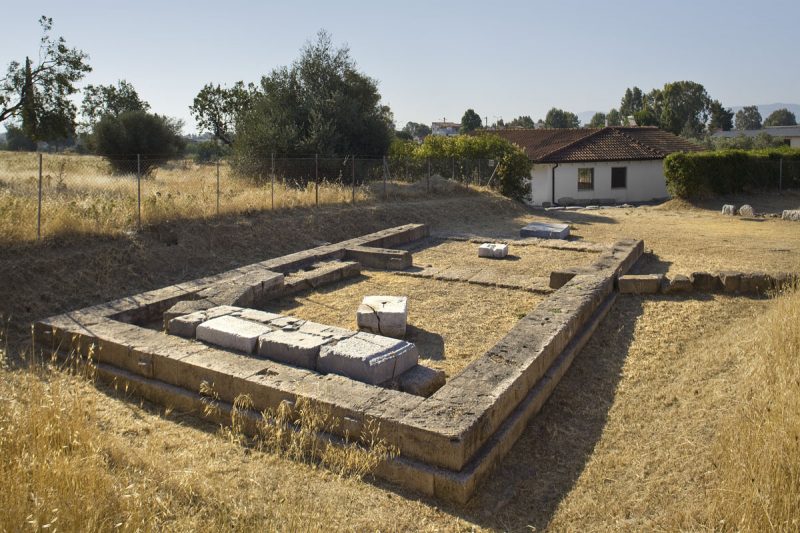Fieldwork and studies
Since 1964, Swiss archaeologists have been excavating and studying the remains of the ancient city of Eretria, on the island of Euboea, but clearly much remains to be discovered: only a tiny part of the site has been excavated, while the materials deposited in the Museum and the documentation of older excavations have not yet yielded all the information they hold. Moreover research issues have considerably evolved during the last 50 years and research activities have recently extended beyond the city walls, to explore the territory of the ancient polis of Eretria. Below are some of the past and ongoing projects the Swiss School has been carrying.
The Gymnasium of Eretria (2015–2019)
A three-year excavation program in the Gymnasium of Eretria was carried out between 2015 and 2019 to explore the eastern part of the building and to clarify its chronology. The double-courtyard plan of the Gymnasium was probably motivated by the use of distinct spaces by two different age groups. It is one of the rare occurence of such buildings throughout Greece. A second palaestra located near the harbor of Eretria was investigated in 2018 in order to get a thorough understanding of the institution of the gymnasium in the city.
More informationThe Ceramic Industry of Eretria (2012–2019)
An interdisciplinary program started in 2012 combines macroscopic, petrographic and chemical analyses (WD-XRF) towards a diachronic investigation of pottery production and supply on the site from the Early Bronze Age to the Roman period. Based on 425 pottery samples carefully selected from stratified deposits, the main objective is to characterise, both compositionally and technologically, local Eretrian production tracing variations and changes in local craftsmanship over time, but also imported vessels investigating the site’s changing role in regional and interregional networks.
More informationThe Roman Baths (2009–2014)
The Roman Baths of Eretria were excavated south of the temple of the imperial cult between 2009 and 2014. The building extends on more than 400m2 and displays the characteristic rooms: a hallway leading into the changing room, then a series of cold, warm and hot rooms with basins, and finally a courtyard for leisure
activities, surrounded by porticoes. Large kilns used to produce lime for mortar were also uncovered to the north of the complex, as well as a Late Hellenistic–Early Imperial tholos baths. The Roman baths were in use from the end of the 2nd century AD until the middle of the 3rd century AD. The monument was published in 2020 (Eretria XXV) and the Swiss School is now endeavouring to restore and develop the archaeological remains.
Further reading
AntK 58, 2015, 136–143; 57, 2014, 116–126; 56, 2013, 90–100; 55, 2012, 140–151; 54, 2011, 135–142; 53, 2010, 141–146.
Guy ACKERMANN – Marc DURET, La céramique des thermes romains d’Erétrie. ReiCretActa 43, 2014, 1-8.
Thierry THEURILLAT – Guy ACKERMANN – Marc DURET – Simone ZURBRIGGEN, Les thermes du centre (ERETRIA XXV).
The Sanctuary of Athena (2006–2014)
The remains of the sanctuary of Athena were unearthed in the early nineties on the rocky summit of the acropolis. Established above a Bronze Age settlement, this place of cult was frequented between the end of the 7th century and the beginning of the 2nd century BC. The architectural structures have almost entirely disappeared, except for a large esplanade carved out of the rock, but abundant votive material gives evidence to apprehend the ritual practices which took place in the sanctuary. Thousands of pottery vases, mostly ritual, including Archaic miniature hydrias and high-neck jugs, as well as a large number of terracotta female figurines as well as weights, spindle whorls, and epinetra, which refer to the domain of weaving of which Athena was the patroness.
Further reading
AntK 58, 2015, 132–136; 51, 2008, 148–153; 50, 2007, 119-129
Sandrine HUBER – Pauline MAILLARD, Cavaliers et dédicantes: les terres cuites de l’Athénaion et la communauté civique d’Érétrie. In S. Haxhi-Huysecom – A. Muller (eds), Figurines en contexte : iconographie et fonction(s). Villeneuve d’Ascq 2015, 157-178
The territory of Eretria (2004–2012)
For many years Swiss archaeologists were primarily focused on the intra-muros settlement of Eretria. More recently, a growing interest in the wider setting of the ancient city has yielded significant results. The polis of Eretria extended far beyond its fortification walls. Its territory, the “Eretriad”, covered at the end of the 4th c. BC some 1300km2 and was among the largest in continental Greece during Classical Antiquity. The civic organization of this territory and the exploitation of its resources have been the subject of in-depth historical and archaeological studies. The territory comprised hundreds of demes, farms, fortified sites and places of worship.
Further reading
Denis KNOEPFLER, Les territoire d’Erétrie et l’organisation politique de la cité (dêmoi, chôroi, phylai). In M. H. Hansen (ed.), The Polis as an Urban Centre and the Political Community. Symposium August, 29–31 1996, Acts of the Copenhagen Polis Centre vol. 4. Copenhagen 1997, 352–449.
Sylvian FACHARD, La défense du territoire. Étude de la chôra érétrienne et de ses fortifications. ERETRIA XXI, Fouilles et recherches. Gollion 2012.
Eretria-Amarynthos Survey Project (EASP 2021-2025)
The ongoing research project “Amarynthos and the Making of the Eretrian Sacred Landscape” includes a multidisciplinary regional survey project whose goal is to study the integration of the Artemision within the ancient landscape. The first axis of the project mainly deals with the region’s archaeology, human ecology, and history from the Bronze Age to the Byzantine period, while the second tackles issues that are more specific to the sanctuary of Artemis, such as the relations between the shrine and the demes, the trace of the sacred way (hiera odos), and the topography of the religious landscape.
EASP 2021-2025The Sanctuary of Apollo Daphnephoros (1998–2003)
The Sanctuary of Apollo Daphnephoros, the poliad deity of the Eretrians, was built in the 8th century BC. Excavations by Swiss archaeologists started in 1964 and were extended between 1998 and 2003 after a period of interruption. The main goal was to clarify the spatial organization and chronological development of the Early Iron Age sanctuary. During the Late Geometric II, the construction of a monumental edifice aligned with the altar brought new magnitude to the sacred area, with ample evidence of worship: votive objects were found in the monumental building as well as in the vicinity of the altar. Cult activities include animal sacrifices at the altar, banquets and presentation of prestigious votive offerings, as well as processions and dances.
Further reading
Samuel VERDAN, Le Sanctuaire d’Apollon Daphnéphoros à l’époque géométrique. ERETRIA XXII, Fouilles et recherches. Gollion 2013
The Sebasteion (1996–2001)
The main crossroad of Eretria was excavated during five seasons. Important archaeological remains dating mainly from the Late Hellenistic to the Imperial periods were uncovered, in particular a Sebasteion. The temple of the imperial cult erected in the Early Principate hosted several statues of members of the Augustan, Julio-Claudian, Antonine and Severan dynasties, of which hundreds of marble fragments were recovered during excavations.
Workshop facilities (dyeing?) of the early 1st cent. A.D. to the mid–2nd cent. A.D as well as a limekiln and (possibly) latrinae were are also uncovered on either sides of the main road.
Old excavations
The field investigations of the Swiss archaeologists have essentially been limited to certain sectors of the ancient city:
- The houses of the West Quarter (1966–1978, 1988–1989, 2005, 2008) and the West Gate (1964–1969)
- The Heroon (1965–1978)
- The eastern sector F/5 (1966–1968)
- The canal (1972–1973, 1976, 1981) and the grave terrace B/3N (1967–1970)
- The House of the Mosaics (1972, 1975–1980)
- The Roussos quarter next to the port (1979)
- The eastern stoa of the Agora and the Bouratza quarter (1979–1982)
